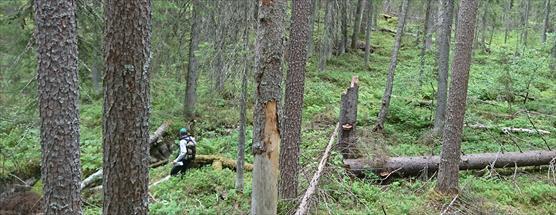NEWS
Defense: Spatial conservation prioritization for the improvement of the national protected-area network
The thesis concerns identifying the most important areas from the biodiversity perspective in Finland. The studies include forest, mires, and the Natura 2000 network. Also, areas with the least value for biodiversity were recognized, which enables targeting actions that harm nature there. According to the results, there are significant differences between areas in terms of the biodiversity being supported. When the most important areas for biodiversity are known, conservation measures can be executed in a cost-effective manner. M. Sc. Ninni Mikkonen, who works at Syke, defended the doctoral dissertation in the University of Helsinki, on 20 September 2024. More information here.
New releases!
-
National high-resolution conservation prioritisation of boreal forests https://doi.org/10.1016/j.foreco.2023.121079 (Mikkonen, Leikola, Lehtomäki, Halme, Moilanen. Forest Ecology And Management. 6 June 2023)
-
Input data resolution affects the conservation prioritization outcome of spatially sparse biodiversity features https://doi.org/10.1007/s13280-023-01885-6 (Tanhuanpää, Mikkonen, Kujala, Heinaro, Mäyrä & Kumpula. AMBIO. 2 June 2023)
-
High focus on threatened species and habitats may undermine biodiversity conservation: Evidence from the northern Baltic Sea https://doi.org/10.1111/ddi.13710 (Virtanen & Moilanen. Diversity and Distributions. 2 May 2023)
New version of the Zonation software is released 18.5.2022
Zonation 5 is arguably the most powerful approach to spatial priority ranking currently available. The software is computationally highly efficient and straightforward to use. With suitable combinations of data and analysis setups, many different analytical needs can be answered.
In Finland, Zonation analyses have been utilized in several national-scale conservation projects during the last ten years. As part of the Forest Biodiversity Programme METSO 2008–2025, the conservation area network has been expanded twice in state-owned forests and the use of Zonation has had an important role in the final decisions. Zonation analyses have also been developed 3 times (in the years 2012, 2016 and 2018) to support the voluntary-based establishment of forest conservation areas and pro-biodiversity forest management plans in privately-owned areas. In 2014–2015, Zonation results served in developing a supplementary mire conservation programme.
The forest owner also benefits from Zonation analyses: the results are used to inform land owners about sites that might be suitable for voluntary protection through the METSO programme.
The development of Zonation analyses to support national and regional conservation and land use planning takes place through a broad-based project financed mainly by the Ministry of the Environment and the Ministry of Agriculture and Forestry. Participants include Metsähallitus, the Finnish Environment Institute SYKE, the Finnish Forest Centre, Tapio, the Centres for Economic Development, Transport and the Environment, and the Universities of Helsinki and Jyväskylä.
More information:

Hiidenportti National Park © Ninni Mikkonen